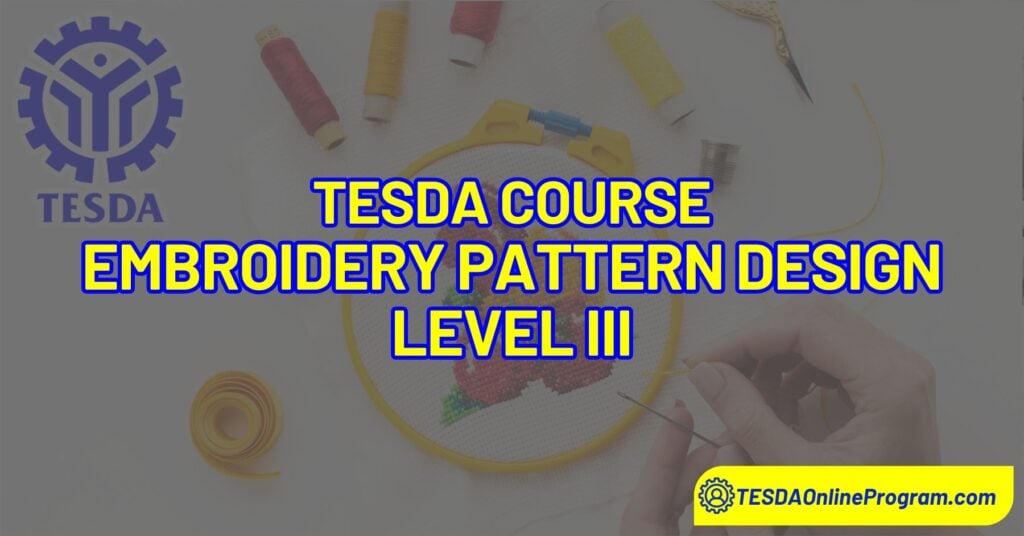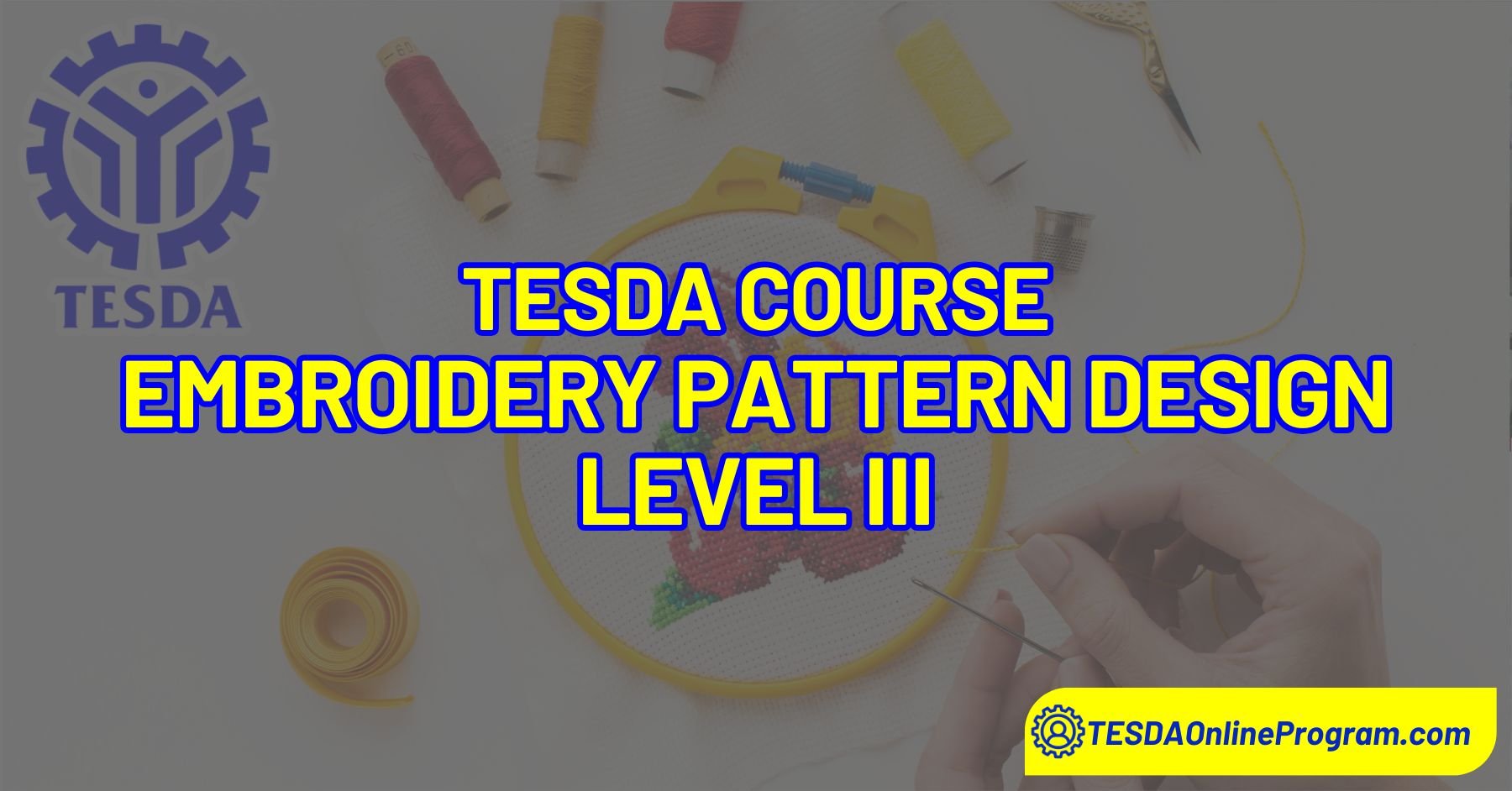The Embroidery Pattern Design Level III Course by TESDA is an advanced training program designed to develop the skills and expertise of individuals in the art of traditional Filipino embroidery. This qualification focuses on mastering intricate techniques such as calado, sombrado, and bordado, which are deeply rooted in the country’s cultural heritage. Learners will gain proficiency in designing unique patterns, preparing materials, and executing detailed embroidery work with precision and creativity. The course emphasizes not only technical skill but also artistic expression, enabling students to create high-quality, culturally significant pieces.
Also read: TESDA Embroidery Level II Course
Beyond the craft itself, the program promotes cultural preservation by encouraging the continuation and innovation of traditional embroidery techniques for future generations. Participants will learn to ensure quality control in their work, blending heritage artistry with modern design trends to meet contemporary market demands. By the end of the course, graduates will be equipped to produce exceptional embroidered pieces, contribute to the local creative industry, and uphold the proud legacy of Filipino craftsmanship.
[toc[

Course Description
This course trains learners in advanced Filipino embroidery techniques such as calado, sombrado, and bordado. It covers pattern creation, material preparation, embroidery execution, quality control, and cultural heritage preservation, equipping graduates to produce high-quality, culturally inspired designs for both traditional and modern applications.
Benefits
Here are several benefits of taking the Embroidery Pattern Design Level III Course by TESDA:
- Master Traditional Techniques – Gain expertise in intricate Filipino embroidery styles like calado, sombrado, and bordado.
- Enhance Creativity – Develop unique pattern designs and artistic skills for both traditional and modern applications.
- Cultural Preservation – Contribute to safeguarding and promoting Philippine embroidery heritage.
- Quality Craftsmanship – Learn proper material preparation and quality control for professional-grade outputs.
- Career Opportunities – Open pathways to work in fashion, home décor, handicraft production, or start your own embroidery business.
- Market Competitiveness – Combine heritage artistry with modern trends to appeal to local and global markets.
- Hands-On Learning – Gain practical experience through guided projects and supervised embroidery work.
- Entrepreneurial Skills – Build the foundation for creating and marketing your own embroidery products.
Units of Competency
Here’s the list with the codes removed and replaced with bullets:
BASIC COMPETENCIES
- Lead workplace communication
- Lead small teams
- Apply critical thinking and problem-solving techniques in the workplace
- Work in a diverse environment
- Propose methods of applying learning and innovation in the organization
- Use information systematically
- Evaluate occupational safety and health work practices
- Evaluate environmental work practices
- Facilitate entrepreneurial skills for micro-small-medium enterprises (MSMEs)
COMMON COMPETENCIES
- Enhance industry knowledge and skills
- Enhance creative and artistic skills and cultural awareness
- Manage own performance
- Maintain a safe, clean, and efficient work environment
- Provide and maintain effective customer service
- Develop artistic skills and cultural awareness of oneself
- Work with tools, materials, and equipment
- Perform mensuration and calculation
CORE COMPETENCIES
- Create embroidery pattern designs
- Develop color schemes and combinations
- Prepare embroidery layouts
- Finalize designs
Sample of Certificate of Completion

Job Opportunities
- Traditional Embroidery Pattern Designer
- Entrepreneur / Small Business Owner
- Artisan / Craft Specialist
Note: These job opportunities do not guarantee employment or income.
Requirements
To enroll in this course, you will need the following documents:
- PSA Birth Certificate
- High School or College Diploma
- Certified True Copy of Official Transcript of Records or Form 137
- Certificate of Good Moral Character or GMRC
- 1 x 1 and/or 2 x 2 pictures
To obtain further details, please reach out to the enrollment site that aligns with your requirements. Kindly note that the criteria may vary.
Also read: TESDA Artisanal Weaving Level II Course
Frequently Asked Questions
1. Who can enroll in this course?
A: Any individual interested in learning advanced Filipino embroidery techniques may enroll. Basic knowledge of embroidery is helpful but not required.
2. What skills will I learn?
A: Learners will gain expertise in:
- Filipino embroidery techniques (calado, sombrado, bordado)
- Pattern design and layout preparation
- Color schemes and combinations
- Material preparation and quality control
- Cultural heritage preservation
3. Is this course recognized by TESDA?
A: Yes, this is a TESDA-accredited Level III qualification, ensuring industry-recognized competency standards.
4. Do I need to bring my own materials?
A: Training centers may provide materials, but some may require students to bring their own embroidery tools and fabrics. It’s best to confirm with the enrollment site.
5. Can I start my own business after the course?
A: Yes, the course includes entrepreneurial skills training for micro, small, and medium enterprises (MSMEs), helping graduates establish and market their embroidery products.
6. Will I receive a certificate after completion?
A: Yes, learners who successfully complete the program will receive a TESDA-accredited certificate for Embroidery Pattern Design Level III.
Summary
The Embroidery Pattern Design Level III Course by TESDA is an advanced program that equips learners with the skills to master traditional Filipino embroidery techniques such as calado, sombrado, and bordado. The course covers pattern design, material preparation, embroidery execution, color schemes, quality control, and cultural heritage preservation, while also fostering creativity, hands-on practice, and entrepreneurial skills. Graduates can pursue careers as embroidery designers, artisans, or small business owners, though employment is not guaranteed. TESDA-accredited, the program ensures industry-recognized competencies and provides a certificate upon successful completion.

